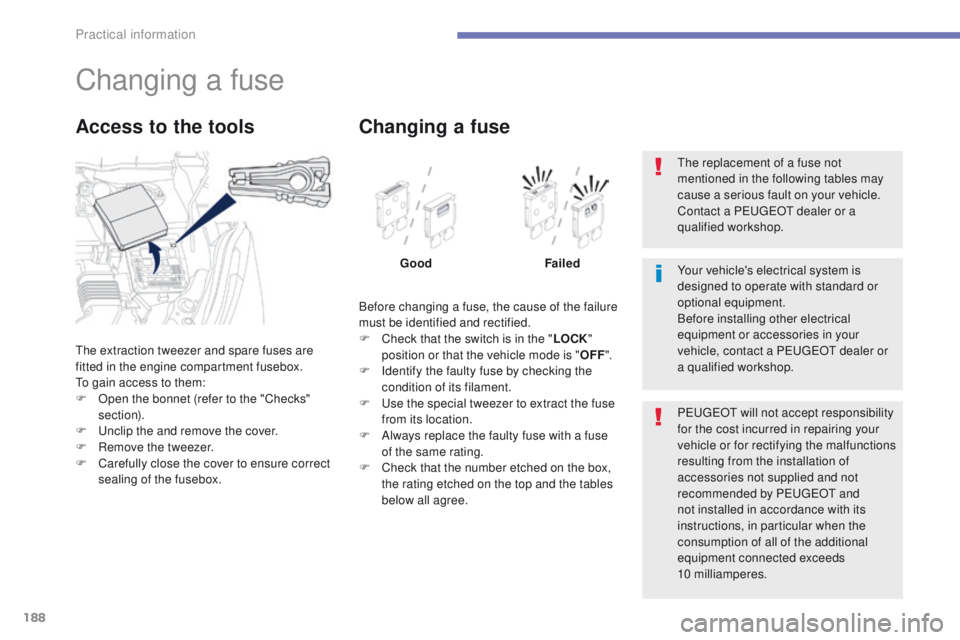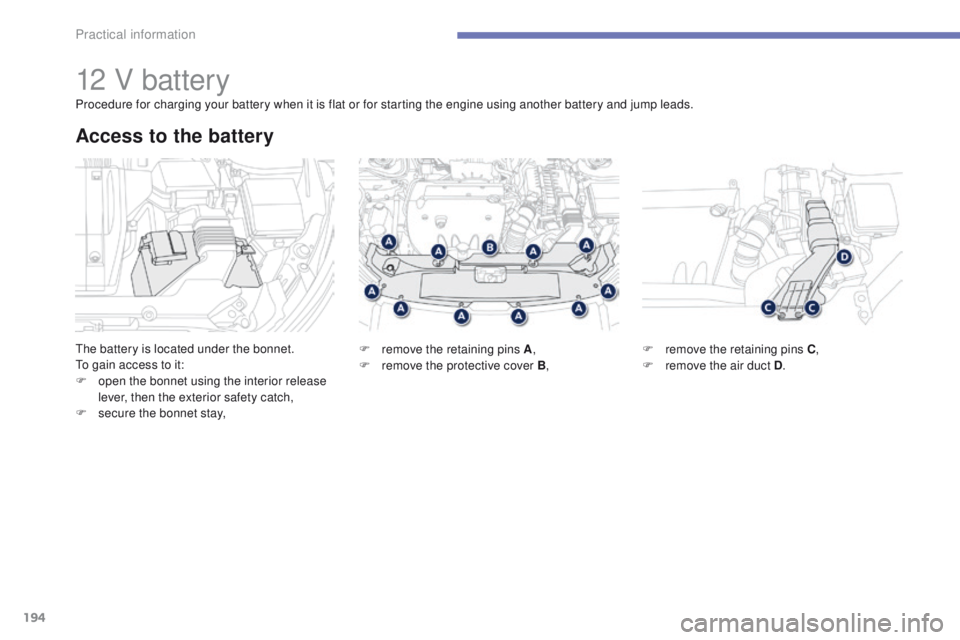2015 PEUGEOT 4008 bonnet
[x] Cancel search: bonnetPage 190 of 389

188
4008_en_Chap07_info-pratiques_ed01-2014
Changing a fuse
the extraction tweezer and spare fuses are
fitted in the engine compartment fusebox.
to g
ain access to them:
F
O
pen the bonnet (refer to the "Checks"
section).
F
u
n
clip the and remove the cover.
F
R
emove the tweezer.
F
C
arefully close the cover to ensure correct
sealing of the fusebox.
Access to the tools
Before changing a fuse, the cause of the failure
must be identified and rectified.
F
C
heck that the switch is in the " LOCK"
position or that the vehicle mode is " OFF".
F
I
dentify the faulty fuse by checking the
condition of its filament.
F
u
s
e the special tweezer to extract the fuse
from its location.
F
A
lways replace the faulty fuse with a fuse
of the same rating.
F
C
heck that the number etched on the box,
the rating etched on the top and the tables
below all agree.
Changing a fuse
Good Failed
P
e
uge
Ot
will not accept responsibility
for the cost incurred in repairing your
vehicle or for rectifying the malfunctions
resulting from the installation of
accessories not supplied and not
recommended by P
e
uge
Ot
and
not installed in accordance with its
instructions, in particular when the
consumption of all of the additional
equipment connected exceeds
10 milliamperes. Your vehicle's electrical system is
designed to operate with standard or
optional equipment.
Before installing other electrical
equipment or accessories in your
vehicle, contact a P
e
uge
Ot
dealer or
a qualified workshop.
th
e replacement of a fuse not
mentioned in the following tables may
cause a serious fault on your vehicle.
Contact a P
e
uge
Ot
dealer or a
qualified workshop.
Practical information
Page 196 of 389

194
4008_en_Chap07_info-pratiques_ed01-2014
12 V battery
the battery is located under the bonnet.to gain access to it:
F
o
pen the bonnet using the interior release
lever, then the exterior safety catch,
F
s
ecure the bonnet stay,
Access to the battery
Procedure for charging your battery when it is flat or for starting the engine using another battery and jump leads.
F
r
emove the retaining pins A,
F
r
emove the protective cover B,F
r
emove the retaining pins C,
F
r
emove the air duct D.
Practical information
Page 209 of 389

207
4008_en_Chap08_verifications_ed01-2014
Bonnet
F Open the left-hand front door.
F P ull the interior bonnet release lever A ,
located at the bottom of the door aperture. Do not open the bonnet in high winds.
When the engine is hot, handle the
exterior safety catch and the bonnet
stay with care (risk of burns).
F u
n
clip the stay C from its housing on the
back of the bonnet.
F
F
ix the stay in the notch to hold the bonnet
open.
Closing
F take the stay out of the support notch.
F C lip the stay in its housing on the back of
the bonnet.
F
L
ower the bonnet and release it at the end
of its travel.
F
P
ull on the bonnet to check that it is
secured correctly.
th
e location of the interior bonnet release
lever prevents opening of the bonnet while
the front left door is closed.
Opening
F Push the exterior safety catch B to the left
and raise the bonnet.
th
is message appears in the instrument panel
screen if the bonnet is not fully closed.
The cooling fan may star t after
switching off the engine; take care
with articles and clothing that might
become caught by the fan blades. Because of the presence of electrical
equipment under the bonnet, it is
recommended that exposure to water
(rain, washing, ...) be limited.
8
Checks
Page 214 of 389

212
4008_en_Chap08_verifications_ed01-2014
Running out of fuel (Diesel)
On vehicles fitted with the 1.6 litre
HDi 110 engine, the fuel system must be
manually primed if you run out of fuel; refer to
the corresponding Diesel engine compartment
view.
1.6 litre HDi engine
F Fill the fuel tank with at least five litres of diesel.
F
O
pen the bonnet.
F
I
f necessary, unclip the styling cover for
access to the priming pump.
F
S
queeze and release the priming pump
repeatedly until resistance is felt (there
may be resistance at the first press).
F
O
perate the starter until the engine starts
(if the engine does not start at the first
attempt, wait around 15 seconds before
trying again).
F
I
f the engine does not start after a few
attempts, operate the priming pump again
then start the engine.
F
C
lip the styling cover back in place.
F
C
lose the bonnet.
Checks
Page 215 of 389

213
4008_en_Chap08_verifications_ed01-2014
Checking levels
take care when working under the bonnet, as certain areas of the engine may be extremely hot (risk of burns) and the cooling fan could start at
any time (even with the ignition off).
Oil level
the check of the the level is done
out with the dipstick, located under
the bonnet. Refer to the description
of your engine compartment for the
position of the dipstick.Engine oil change
Refer to the warranty and maintenance record
for details of the interval for this operation.
In order to maintain the reliability of the engine
and emission control system, never use
additives in the engine oil.
Oil specification
the oil must be the correct grade for your
engine and conform to the manufacturer's
recommendations.
Check all of these levels regularly, in line with the warranty and maintenance record.
t
o
p them up if necessary, unless other wise indicated.
If a level drops significantly, have the corresponding system checked by a P
e
uge
Ot
dealer or a qualified workshop.
Dipstick
there are two marks on the dipstick:
A = maximum
If the level is above this
mark, contact a P
e
uge
Ot
dealer or a qualified
workshop.
B = minimum
to
p up the level through the
oil filler orifice, using the
correct grade of oil for your
engine.
t
h
e level must never
be below this mark.
th
is check will only be correct if the vehicle is
on level ground and the engine has been off for
more than 30 minutes.
It is normal to top up the oil level between
two services (or oil changes). P
e
uge
Ot
recommends that you check the level, and top
up if necessary, every 3 000 miles (5 000 km).
After topping up the oil, the check when
switching on the ignition with the oil level
indicator in the instrument panel is not valid
during the 30 minutes after topping up.
8
Checks
Page 217 of 389

215
4008_en_Chap08_verifications_ed01-2014
Avoid prolonged contact of used oil or
fluids with the skin.
Most of these fluids are harmful to
health or indeed very corrosive.
Do not discard used oil or fluids into
sewers or onto the ground.
ta
ke used oil to a P
e
uge
Ot
dealer or
a qualified workshop (France) or to an
authorised waste disposal site.
Used products
To p p i n g u p
the reservoir must be topped up without delay
by a Pe ugeOt dealer or a qualified workshop.
Additive level
(1.6 HDi 110 Diesel versions
with particle filter)
the additive reservoir low level is indicated by
the display of this message.
Fluid specification
For optimum cleaning, this fluid must not be
topped up with or replaced with plain water.
Screenwash and headlamp
wash fluid
to check or top up the fluid, stop the
vehicle, apply the parking brake and
switch off the engine.
F
O
pen the bonnet and secure it with the
st ay.
F
O
pen the filler cap for the screenwash
reservoir.
F
C
heck the level using the gauge, then top-
up if necessary.
F
R
efit the cap on the reservoir and close the
bonnet. In wintry conditions, the use of fluid with
an ethyl alcohol or methanol base is
recommended.
8
Checks
Page 237 of 389

235
4008_en_Chap09_caracteristiques-techniques_ed01-2014
Identification markingsVarious visible markings for the identification and tracing of your vehicle.
A.
M
anufacturer's plate.
I
t is riveted to the right hand middle pillar
and carries the following information:
-
manufacturer,
-
eu type approval number,
-
v
ehicle identification number (VIN),
-
g
ross vehicle weight,
-
g
ross train weight,
-
m
aximum front axle weight,
-
m
aximum rear axle weight.
th
e tyre pressures must be checked
when the tyres are cold, at least once
a month.
If the tyre pressures are too low, this
increases fuel consumption.
B.
T
yre label.
t
h
is label is affixed to the the driver's
side middle pillar and carries the following
information:
-
t
yre sizes,
-
t
yre pressures.C.
V
ehicle Identification Number (VIN)
under the bonnet.
t
h
is number is engraved on the bodywork
near the damper support.
9
technical data
Page 337 of 389

335
4008_en_Chap11_index-alpha_ed01-2014
ABS and eBFD systems ...............................142
Accessories .................................................. 204
Accessory socket, 12V
......................90, 92, 93
Access to bulbs
............................................. 183
Active stability control (ASC)
........................14 4
Adjusting headlamps
.................................... 13 3
Adjusting head restraints
................................73
Adjusting seat belt height
............................. 14
6
Adjusting the steering wheel
..........................79
Airbag, knee
.......................................... 152, 15 4
Airbags
.......................................................... 150
Airbags, curtain
..................................... 15
3, 15 4
Airbags, front ......................................... 150, 15 4
Airbags, lateral
...................................... 152, 15 4
Air conditioning
......................................... 10, 81
Air conditioning, automatic
................................................ 8
1, 8 4
Air conditioning, manual
...........................81, 82
Air filter
.......................................................... 216
Air flow
..............................
..............................80
Air intake
................................................... 83, 86
Air vents
.......................................................... 80
Alarm
............................................................... 65
Anti-lock braking system (ABS)
....................142
Anti-theft
................................................. 61, 102
Apple
® player ............... 2 78, 279, 280, 304, 306
Armrest, front ...................................... 74, 90, 93
Armrest, rear
................................................... 76
A
SC
........
....................................................... 14 4
Ashtray, portable
....................................... 90, 92
Audible warning
............................................ 141
Audio-CD
..............................
.......276, 303, 323
Audio file formats
.......................................... 2
76
Audio streaming (Bluetooth)
..............................
............330, 331
Audio systems
............................... 249, 289, 311
Audio-telematics
........................................... 249
Automatic illumination of headlamps
...................................... 128, 13 0Automatic operation of hazard
warning lamps
............................................
141
Automatic rain sensitive windscreen wipers
......................................
13 6
Automatic switching off of lighting
..............................
......................
13 0
Auxiliary sockets
...........
94, 278 -281, 304-308, 328 -329
ACCapacity, fuel
tank ............................................................. 210
CD changer
...............................
....................325
CD MP3
........................................ 276, 303, 325
Central locking
.......................................... 52-59
Changing a bulb
..................................... 182-187
Changing a fuse
..................................... 18 8 -19 3
Changing a wheel
.................................. 175 -178
Changing a wiper blade
........................................................... 197
Changing the remote control battery
........................................................... 60
C
hanging the time
.............................. 44, 46, 49
Checking levels
...................................... 21
3 -215
Checking the engine oil level
........................................................ 213
Checks
...............
.................................... 2 07-218
Children
...............................
...149, 151, 155 -170
Child lock
...............................
........................170
Child seats
..............................
............15 6, 15 6,
160 -162, 169
Child seats, ISOFIX
...................................... 16
6
Cigarette lighter ............................................... 92
Closing the boot
.............................................. 63
Closing the doors
............................................ 62
Colour screen
....................... 2
50, 253, 290, 293
Connectors, audio
........................... 9
4, 278 -281,
304, 305, 328 -329
Controls for air conditioning
....................................... 82, 84
Coolant
...............................
.............................35
Coolant level
................................................. 214
Courtesy lamp, front
............................................................. 13 8
Courtesy lamp, rear
...................................... 13 9
Cruise control
................................................ 12
0
Cup holder
...............................
........................90
CV
t g
earbox
......................................... 10 5 , 217
Battery
................................................... 19 4, 216
Battery, charging
........................................... 19 6
Battery, remote control
............................. 6
0, 61
Bluetooth (telephone)
.................... 237, 288, 308
Bluetooth telephone with voice recognition
.......................... 2 37-24 8
Bonnet
........................................................... 207
Bonnet stay
................................................... 207
Boot
................................................................. 63
Boot lamp
...................................................... 140
Bottle holder
.................................................... 90
Brake discs
.................................................... 2
18
Brake lamps
.................................................. 18 6
Brake pads
.................................................... 218
Braking assistance system
......................................................... 142
Bulbs (changing, type)
........................... 18
2-187
B
.
Alphabetical index